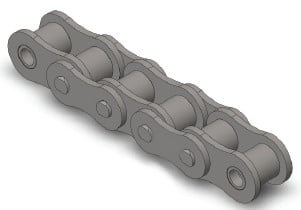The following techniques must be used to select chain and sprocket sizes, ascertain the minimal center distance, and determine the length of chain desired in pitches. We are going to principally use Imperial units (such as horsepower) in this part having said that Kilowatt Capacity tables are available for every chain size inside the preceding area. The variety system could be the same irrespective on the units applied.
Phase one: Decide the Class with the Driven Load
Estimate which of the following greatest characterizes the affliction with the drive.
Uniform: Smooth operation. Tiny or no shock loading. Soft start up. Moderate: Regular or moderate shock loading.
Heavy: Severe shock loading. Regular starts and stops.
Stage two: Identify the Service Aspect
From Table 1 below establish the ideal Support Element (SF) for the drive.
Step three: Calculate Design Energy Necessity
Design Horsepower (DHP) = HP x SF (Imperial Units)
or
Style Kilowatt Power (DKW) = KW x SF (Metric Units)
The Style and design Energy Necessity is equal on the motor (or engine) output power instances the Service Component obtained from Table 1.
Stage 4: Make a Tentative Chain Selection
Create a tentative choice of the demanded chain size from the following method:
one. If working with Kilowatt power – fi rst convert to horsepower for this stage by multiplying the motor Kilowatt rating by one.340 . . . That is important since the quick selector chart  is proven in horsepower.
is proven in horsepower.
two. Locate the Style Horsepower calculated in phase three by reading through up the single, double, triple or quad chain columns. Draw a horizontal line by this value.
three. Locate the rpm on the modest sprocket about the horizontal axis of the chart. Draw a vertical line via this value.
four. The intersection from the two lines ought to indicate the tentative chain choice.
Stage five: Choose the quantity of Teeth for the Small Sprocket
After a tentative choice of the chain size is manufactured we need to establish the minimal variety of teeth necessary about the small sprocket required to transmit the Layout Horsepower (DHP) or even the Design Kilowatt Energy (DKW).
Phase six: Determine the amount of Teeth for that Huge Sprocket
Make use of the following to calculate the quantity of teeth to the significant sprocket:
N = (r / R) x n
The amount of teeth over the significant sprocket equals the rpm of your small sprocket (r) divided from the wanted rpm of your significant sprocket (R) times the amount of teeth within the compact sprocket. If the sprocket is as well substantial for the space available then many strand chains of the smaller sized pitch need to be checked.
Phase 7: Establish the Minimal Shaft Center Distance
Utilize the following to determine the minimum shaft center distance (in chain pitches):
C (min) = (2N + n) / six
The over can be a manual only.
Phase eight: Check the Final Variety
Moreover bear in mind of any likely interference or other area limitations that could exist and adjust the variety accordingly. On the whole essentially the most efficient/cost eff ective drive utilizes single strand chains. This is often because several strand sprockets are extra costly and as is usually ascertained from the multi-strand components the chains come to be significantly less effi cient in transmitting energy because the amount of strands increases. It can be consequently frequently best to specify single strand chains anytime feasible
Stage 9: Ascertain the Length of Chain in Pitches
Utilize the following to calculate the length from the chain (L) in pitches:
L = ((N + n) / 2) + (2C) + (K / C)
Values for “K” may very well be identified in Table 4 on web page 43. Try to remember that
C is the shaft center distance offered in pitches of chain (not inches or millimeters and so on). In the event the shaft center distance is known in the unit of length the worth C is obtained by dividing the chain pitch (during the same unit) through the shaft centers.
C = Shaft Centers (inches) / Chain Pitch (inches)
or
C = Shaft Centers (millimeters) / Chain Pitch (millimeters)
Note that every time doable it’s finest to use an even amount of pitches so that you can stay clear of using an off set link. Off sets never possess the identical load carrying capacity as the base chain and should really be avoided if possible.
